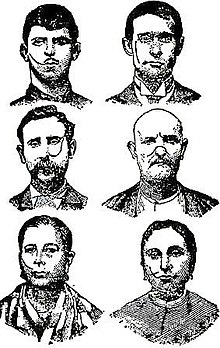Camorra
| Camorra | |
|---|---|
 | |
| Presumed Origin | the Spanish Garduna |
| Creation | XVI century |
| Actual Number | 84,700 members |
| Principals Families | over 200 'clans' |
| Activities | Blackmail, Illegal gambling, Casino, Prostitution, Trafficking |
The Camorra is a mafia-like criminal organisation, or secret society, in the region of Campania and the city of Naples in Italy.
Background
The Camorra was at its height in the 19th century, when the Bourbon monarchy in Naples used its members in the police, army, and civil service. Once Naples became a part of a united Italy in 1861, the Camorra was suppressed and many of its members fled to the United States where they joined the Italian-American Mafia. The Camorra was supplanted after Benito Mussolini's takeover in 1922. Compared to its counterparts elsewhere in Italy, Sacra corona unita in Puglia and 'Ndrangheta in Calabria, it was more involved in piracy. Also, compared to the Sicilian Cosa Nostra's pyramidal structure, the Camorra is made up of many clans that often fight each other. Drive-by shootings by camorristi often result in casualties among the local populations, but such episodes are often difficult to investigate because of widespread Omertà (code of silence). Raffaele Cutolo made an attempt to unify the Camorra families in the manner of the Sicilian Mafia, by forming the New Organized Camorra (Nuova Camorra Organizzata or NCO), but this proved unsuccessful. The Camorra is said by some authoritative sources to have originated with the Garduna, a late-Middle-Ages criminal society based in Seville, Spain, which was transported to Naples when Spain took control of the region.
The Camorra is structured differently according to its location. In the urban areas of Naples such as Secondigliano, the organization lacks in hierarchy due to the geography of the urban apartment style housing. In areas such as Casal di Principe, a more Sicilian structure with a proper hierarchy can be found, with less power disputes and more stable structure.
Since the mid-1990s, the Camorra has taken over the handling of garbage disposal in the region of Campania, with disastrous results for the environment and the health of the general population. Heavy metals, industrial waste and chemicals and household garbage are frequently mixed together, dumped near roads and burnt to avoid detection, leading to a severe soil and air pollution. As of June 2007, the region has no serviceable dumping sites and no alternatives have been found. Together with corrupt local officials and unscrupulous industrialists from all over Italy, the Camorra has created a cartel that has so far proved very difficult to combat for officials.[1]
Presence in America
The Camorra existed in USA between the mid-1800s and early 1900s. They rivaled the Morello crime family for power in New York. Eventually, they melded with the early American Mafia groups.
Presence outside Italy
Scotland has had its brush with the Camorra. Antonio La Torre of Aberdeen, Scotland was a "Don" of the Camorra. He was convicted in Scotland and is awaiting extradition to Italy[2].

Trivia
- Camorra is a 1972 movie, directed by Pasquale Squitieri, starring Fabio Testi and Jean Seberg.
- Gamorrah, investigates the activities of the Camorra in Italy, Germany and Scotland.
See also
Towns with a strong influence of Camorra in their economic life (according to a 2000 report of the Italian Parliament):
Notes
- ^ Dagens Nyheter, April 7, 2007, retrieved on June 19, 2007[1]
References
- "Politics & Racket. To train in earth of boss"
- Roberto Saviano - journalist and writer on various aspects of Camorra
External links
- Camorra's clans
- „Die Camorra“
- Articles by Roberto Saviano published on Nazione Indiana
- Press release of Gomorra Gomorra at Bologna, 27-06-2006, by Wu Ming (AUDIO)
- Il Sistema Camorra, Interviewed by Arcoiris TV (VIDEO)
- Time on Roberto Saviano
